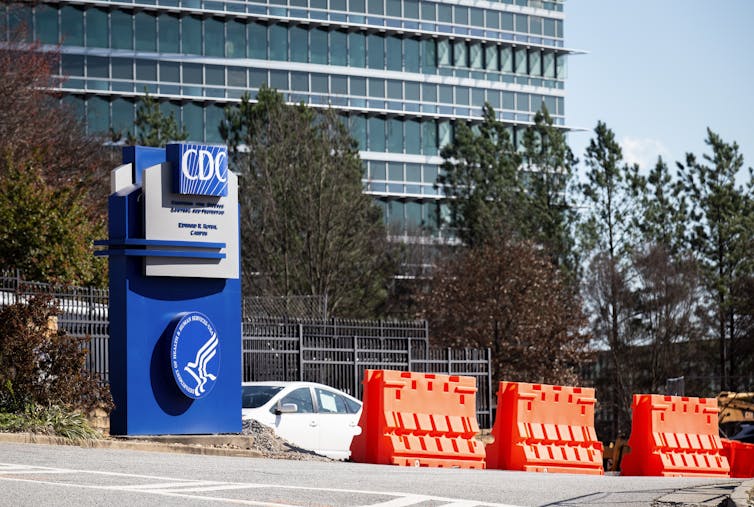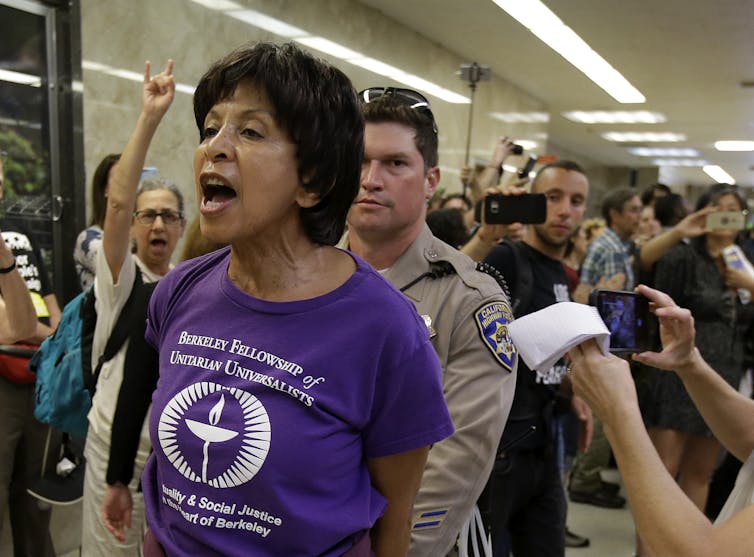Experts agree that Trump's coronavirus response was poor, but the US was ill-prepared in the first place
- Written by Simon F. Haeder, Assistant Professor of Public Policy, Pennsylvania State University
As the coronavirus pandemic exerts a tighter grip on the nation, critics of the Trump administration have repeatedly highlighted the administration’s changes to the nation’s pandemic response team[1] in 2018 as a major contributor to the current crisis. This combines with a hiring freeze[2] at the Centers for Disease Control and Prevention, leaving hundreds of positions unfilled. The administration also has repeatedly sought to reduce CDC funding by billions of dollars[3]. Experts agree[4] that the slow and uncoordinated response has been inadequate and has likely failed to mitigate the coming widespread outbreak in the U.S.
As a health policy expert[5], I agree with this assessment. However, it is also important to acknowledge that we have underfunded our public health system[6] for decades, perpetuated a poorly working health care system[7] and failed to bring our social safety nets in line[8] with other developed nations. As a result, I expect significant repercussions for the country, much of which will disproportionately fall on those who can least afford it.
 The Centers for Disease Control and Prevention in Atlanta, March 6, 2020. President Trump visited the CDC that day in an effort to calm fears about coronavirus.
AP Photo/Ron Harris[9]
The Centers for Disease Control and Prevention in Atlanta, March 6, 2020. President Trump visited the CDC that day in an effort to calm fears about coronavirus.
AP Photo/Ron Harris[9]
Decades of underfunding
Spending on public health has historically proven to be one of humanity’s best investments. Indeed, some of the largest increases in life expectancy[10] have come as the direct result of public health interventions, such as sanitation improvements and vaccinations.
Even today, return on investments for public health spending is substantial and tends to significantly outweigh[11] many medical interventions. For example, one study found that every US$10 per person spent by local health departments[12] reduces infectious disease morbidity by 7.4%.
However, despite their importance to national well-being, public health expenditures have been neglected at all levels. Since 2008, for example, local health departments have lost more than 55,000 staff[13]. By 2016, only about 133,000 full-time equivalent staff[14] remained. State funding for public health was lower in 2016-2017 than in 2008-2009[15]. And the CDC’s prevention and public health budget has been flat and significantly underfunded for years[16]. Overall, of the more than $3.5 trillion the U.S. spends annually on health care, a meager 2.5%[17] goes to public health.
Not surprisingly, the nation has experienced a number of outbreaks of easily preventable diseases. Currently, we are in the middle of significant outbreaks of hepatitis A (more than 31,000 cases[18]), syphilis (more than 35,000 cases[19]), gonorrhea (more than 580,000 cases[20]) and chlamydia (more than 1,750,000 cases[21]). Our failure to contain known diseases bodes ill for our ability to rein in the emerging coronavirus pandemic.
Failures of health care systems
Yet while we have underinvested in public health, we have been spending massive and growing[22] amounts of money on our medical care system. Indeed, we are spending more than any other country for a system that is significantly underperforming[23].
To make things worse, it is also highly inequitable. Yet, the system is highly profitable for all players[24] involved. And to maximize income, both for- and nonprofits have consistently pushed for greater privatization and the elimination of competitors[25].
As a result, thousands of public and private hospitals[26] deemed “inefficient” because of unfilled beds have closed[27]. This eliminated a significant cushion in the system to buffer spikes in demand.
At any given time, this decrease in capacity does not pose much of a problem for the nation. Yet in the middle of a global pandemic, communities will face significant challenges without this surge capacity. If the outbreak mirrors anything close to what we have seen in other countries, “there could be almost six seriously ill patients for every existing hospital bed[28].” A worst-case scenario from the same study puts the number at 17 to 1. To make things worse, there will likely be a particular shortage ofunoccupied intensive care beds[29].
Of course, the lack of overall hospitals beds is not the most pressing issue. Hospitals also lack the levels of staffing and supplies[30] needed to cope with a mass influx of patients. However, the lack of ventilators[31] might prove the most daunting challenge.
 Virginia Hollins-Davidson is taken away by a California Highway Patrol officer after she and other protesters blocked the door to the governor’s office during a protest by the Poor People’s Campaign at the Capitol, June 18, 2018, in Sacramento, Calif.
AP Photo/Rich Pedroncelli[32]
Virginia Hollins-Davidson is taken away by a California Highway Patrol officer after she and other protesters blocked the door to the governor’s office during a protest by the Poor People’s Campaign at the Capitol, June 18, 2018, in Sacramento, Calif.
AP Photo/Rich Pedroncelli[32]
Limits of the overall social safety net
While the U.S. spends trillions of dollars each year on medical care, our social safety net has increasingly come under strain. Even after the Affordable Care Act[33], almost 30 million Americans[34] do not have health insurance coverage. Many others are struggling with high out-of-pocket payments[35].
To make things worse, spending on social programs, outside of those protecting the elderly, has been shrinking, and is significantly smaller than in other developed nations[36]. Moreover, public assistance is highly uneven[37] and differs significantly from state to state.
And of course, the U.S. heavily relies on private entities, mostly employers, to offer benefits taken for granted in other developed countries, including paid sick leave[38] and child care[39]. This arrangement leaves 1 in 4 American workers[40] without paid sick leave, resulting in highly inequitable coverage. As a result, many low-income families struggle to make ends meet even when times are good.
Can the US adapt?
I believe that the limitations of the U.S. public health response and a potentially overwhelmed medical care system are likely going to be exacerbated by the blatant limitations of the U.S. welfare state. However, after weathering the current storm, I expect us to go back to business as usual relatively quickly. After all, that’s what happened after every previous pandemic, such as H1N1 in 2009[41] or even the 1918 flu epidemic[42].
The problems are in the incentive structure for elected officials[43]. I expect that policymakers will remain hesitant to invest in public health, let alone revamp our safety net. While the costs are high, particularly for the latter, there are no buildings to be named, and no quick victories to be had. The few advocates for greater investments lack resources compared to the trillion-dollar interests from the medical sector.
Yet, if altruism is not enough, we should keep reminding policymakers that outbreaks of communicable diseases pose tremendous challenges for local health care systems and communities. They also create remarkable societal costs. The coronavirus serves as a stark reminder.
[You need to understand the coronavirus pandemic, and we can help. Read our newsletter[44].]
References
- ^ changes to the nation’s pandemic response team (theconversation.com)
- ^ hiring freeze (t.co)
- ^ reduce CDC funding by billions of dollars (theconversation.com)
- ^ Experts agree (www.vox.com)
- ^ health policy expert (scholar.google.com)
- ^ underfunded our public health system (www.tfah.org)
- ^ poorly working health care system (theconversation.com)
- ^ failed to bring our social safety nets in line (www.epi.org)
- ^ AP Photo/Ron Harris (www.apimages.com)
- ^ largest increases in life expectancy (www.sciencedirect.com)
- ^ is substantial and tends to significantly outweigh (www.ncbi.nlm.nih.gov)
- ^ every US$10 per person spent by local health departments (www.academyhealth.org)
- ^ 55,000 staff (www.tfah.org)
- ^ about 133,000 full-time equivalent staff (nacchoprofilestudy.org)
- ^ lower in 2016-2017 than in 2008-2009 (www.tfah.org)
- ^ significantly underfunded for years (www.tfah.org)
- ^ meager 2.5% (www.tfah.org)
- ^ more than 31,000 cases (www.cdc.gov)
- ^ more than 35,000 cases (www.cdc.gov)
- ^ more than 580,000 cases (www.cdc.gov)
- ^ more than 1,750,000 cases (www.cdc.gov)
- ^ massive and growing (www.tfah.org)
- ^ significantly underperforming (theconversation.com)
- ^ highly profitable for all players (www.penguinrandomhouse.com)
- ^ greater privatization and the elimination of competitors (doi.org)
- ^ thousands of public and private hospitals (doi.org)
- ^ have closed (theconversation.com)
- ^ there could be almost six seriously ill patients for every existing hospital bed (www.usatoday.com)
- ^ unoccupied intensive care beds (www.niskanencenter.org)
- ^ lack the levels of staffing and supplies (www.nytimes.com)
- ^ ventilators (www.centerforhealthsecurity.org)
- ^ AP Photo/Rich Pedroncelli (www.apimages.com)
- ^ Affordable Care Act (doi.org)
- ^ almost 30 million Americans (www.kff.org)
- ^ high out-of-pocket payments (www.healthsystemtracker.org)
- ^ shrinking, and is significantly smaller than in other developed nations (www.brookings.edu)
- ^ highly uneven (doi.org)
- ^ paid sick leave (www.worldpolicycenter.org)
- ^ child care (www.oecd.org)
- ^ 1 in 4 American workers (www.pewresearch.org)
- ^ H1N1 in 2009 (theconversation.com)
- ^ 1918 flu epidemic (theconversation.com)
- ^ incentive structure for elected officials (doi.org)
- ^ Read our newsletter (theconversation.com)
Authors: Simon F. Haeder, Assistant Professor of Public Policy, Pennsylvania State University


